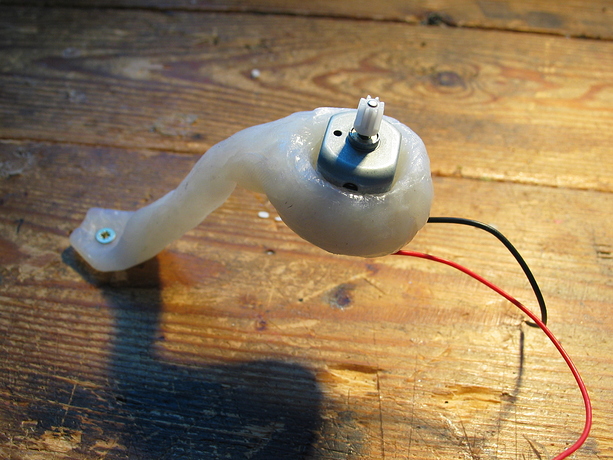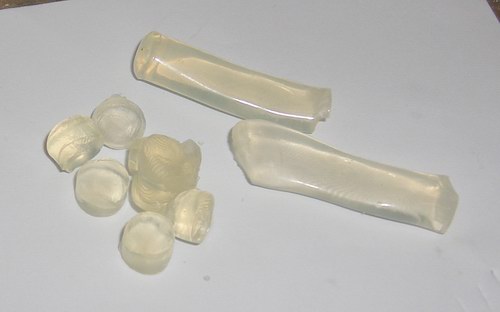thermoset plastics DIY info
here is what I found online, maybe we can find a suitable material for a do it yourself method. I think recycling is an awesome idea myself, this post explains alot and tells a bit about possible materials too. Now I know this is a bit much info but if we could use say old drink bottles to mold robot parts for your self or to sale it seems profitable I mean polymorph is $15 per ounce old drink bottles are free. That is a good markup for any business man and it lightens the load on our landfills and planet too. And I am sure not all info is here either so it will need some trial and error to.
colaboration anyone we can each try a few different matterials!
A Thermoplastic is a polymer in which the molecules are held together by weak secondary bonding forces that soften when exposed to heat and return to its original condition when cooled back down to room temperature. When a thermoplastic is softened by heat, it can then be shaped by extrusion, molding, or pressing. Ice cubes are common household items which exemplify the thermoplastic principle. Ice will melt when heated but readily solidifies when cooled. Like a polymer, this process may be repeated numerous times. Thermoplastics offer versatility and a wide range of applications. They are commonly used in food packaging because they can be rapidly and economically formed into any shape needed to fulfill the packaging function. Examples include milk jugs and carbonated soft drink bottles. Other examples of thermoplastics are:
Polyethylene:
• Packaging
• Electrical insulation
• Milk and water bottles
• Packaging film
• House wrap
• Agricultural film
Polypropylene:
• Carpet fibers
• Automotive bumpers
• Microwave containers
• External prostheses
Polyvinyl Chloride (PVC):
• Sheathing for electrical cables
• Floor and wall coverings
• Siding
• Automobile instrument panels
Thermoplastic and Thermoset Processing Methods
There are a variety of different processing methods used to convert polymers into finished products. Some include:
Extrusion - This continuous process is used to produce films, sheet, profiles, tubes, and pipes. Plastic material as granules, pellets, or powder, is first loaded into a hopper and then fed into a long heated chamber through which it is moved by the action of a continuously revolving screw. The chamber is a cylinder and is referred to as an extruder. Extruders can have one or two revolving screws. The plastic is melted by the mechanical work of the screw and the heat from the extruder wall. At the end of the heated chamber, the molten plastic is forced out through a small opening called a die to form the shape of the finished product. As the plastic is extruded from the die, it is fed onto a conveyor belt for cooling or onto rollers for cooling or by immersion in water for cooling. The operation’s principle is the same as that of a meat mincer but with added heaters in the wall of the extruder and cooling of the product. Examples of extruded products include lawn edging, pipe, film, coated paper, insulation on electrical wires, gutter and down spouting, plastic lumber, and window trim. Thermoplastics are processed by continuous extrusion. Thermoset elastomer can be extruded into weatherstripping by adding catalysts to the rubber material as it is fed into the extruder.
Calendering – This continuous process is an extension of film extrusion. The still warm extrudate is chilled on polished, cold rolls to create sheet from 0.005 inches thick to 0.500 inches thick. The thickness is well maintained and surface made smooth by the polished rollers. Calendering is used for high output and the ability to deal with low melt strength. Heavy polyethylene films used for construction vapor and liquid barriers are calendered. High volume PVC films are typically made using calendars.
Film Blowing – This process continuously extrudes vertically a ring of semi-molten polymer in an upward direction, like a fountain. A bubble of air is maintained that stretches the plastic axially and radially into a tube many times the diameter of the ring. The diameter of the tube depends on the plastic being processed and the processing conditions. The tube is cooled by air and is nipped and wound continuously as a flattened tube. The tube can be processed to form saleable bags or slit to form rolls of film with thicknesses of 0.0003 to 0.005 inches thick. Multiple layers of different resins can be used to make the tube.
Injection Molding - This process can produce intricate three-dimensional parts of high quality and great reproducibility. It is predominately used for thermoplastics but some thermosets and elastomers are also processed by injection molding. In injection molding plastic material is fed into a hopper, which feeds into an extruder. An extruder screw pushes the plastic through the heating chamber in which the material is then melted. At the end of the extruder the molten plastic is forced at high pressure into a closed cold mold. The high pressure is needed to be sure the mold is completely filled. Once the plastic cools to a solid, the mold opens and the finished product is ejected. This process is used to make such items as butter tubs, yogurt containers, bottle caps, toys, fittings, and lawn chairs. Special catalysts can be added to create the thermoset plastic products during the processing, such as cured silicone rubber parts. Injection molding is a discontinuous process as the parts are formed in molds and must be cooled or cured before being removed. The economics are determined by how many parts can be made per cycle and how short the cycles can be.
Blow Molding - Blow molding is a process used in conjunction with extrusion or injection molding. In one form, extrusion blow molding, the die forms a continuous semi-molten tube of thermoplastic material. A chilled mold is clamped around the tube and compressed air is then blown into the tube to conform the tube to the interior of the mold and to solidify the stretched tube. Overall, the goal is to produce a uniform melt, form it into a tube with the desired cross section and blow it into the exact shape of the product. This process is used to manufacture hollow plastic products and its principal advantage is its ability to produce hollow shapes without having to join two or more separately injection molded parts. This method is used to make items such as commercial drums and milk bottles. Another blow molding technique is to injection mold an intermediate shape called a preform and then to heat the preform and blow the heat-softened plastic into the final shape in a chilled mold. This is the process to make carbonated soft drink bottles.
Expanded Bead Blowing – This process begins with a measured volume of beads of plastic being placed into a mold. The beads contain a blowing agent or gas, usually pentane, dissolved in the plastic. The closed mold is heated to soften the plastic and the gas expands or blowing agent generates gas. The result is fused closed cell structure of foamed plastic that conforms to a shape, such as expanded polystyrene cups. StyrofoamTM expanded polystyrene thermal insulation board is made in a continuous extrusion process using expanded bead blowing.
Rotational Molding - Rotational molding consists of a mold mounted on a machine capable of rotating on two axes simultaneously. Solid or liquid resin is placed within the mold and heat is applied. Rotation distributes the plastic into a uniform coating on the inside of the mold then the mold is cooled until the plastic part cools and hardens. This process is used to make hollow configurations. Common rotationally molded products include shipping drums, storage tanks and some consumer furniture and toys.
Compression Molding – This process has a prepared volume of plastic placed into a mold cavity and then a second mold or plug is applied to squeeze the plastic into the desired shape. The plastic can be a semi-cured thermoset, such as an automobile tire, or a thermoplastic or a mat of thermoset resin and long glass fibers, such as for a boat hull. Compression molding can be automated or require considerable hand labor. Transfer molding is a refinement of compression molding. Transfer molding is used to encapsulate parts, such as for semi-conductor manufacturing
The formation of plywood or oriented strand board using thermoset adhesives is a variant of compression molding. The wood veneer or strands are coated with catalyzed thermoset phenol formaldehyde resin and compressed and heated to cause the thermoset plastic to form into a rigid, non-melting adhesive.
Casting – This process is the low pressure, often just pouring, addition of liquid resins to a mold. Catalyzed thermoset plastics can be formed into intricate shapes by casting. Molten polymethyl methacrylate thermoplastic can be cast into slabs to form windows for commercial aquariums. Casting can make thick sheet, 0.500 inches to many inches thick.
Thermoforming – Films of thermoplastic are heated to soften the film, and then the soft film is pulled by vacuum or pushed by pressure to conform to a mold or pressed with a plug into a mold. Parts are thermoformed either from cut pieces for thick sheet, over 0.100 inches, or from rolls of thin sheet. The finished parts are cut from the sheet and the scrap sheet material recycled for manufacture of new sheet. The process can be automated for high volume production of clamshell food containers or can be a simple hand labor process to make individual craft items.
[email protected]





